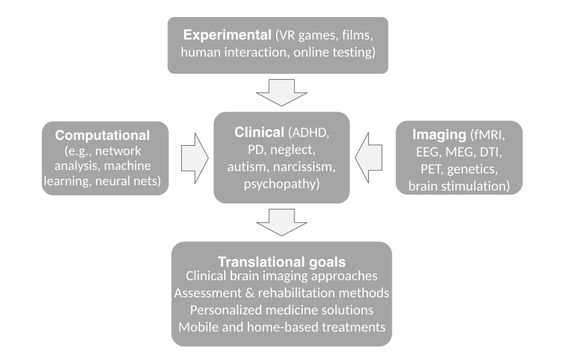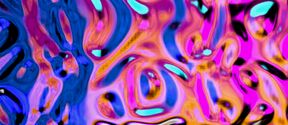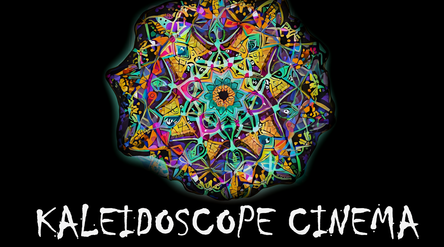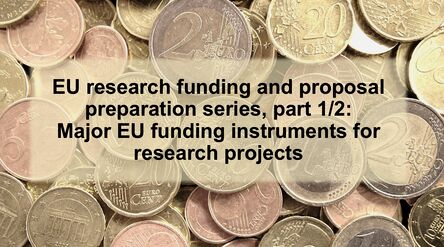Neurotieteen ja lääketieteellisen tekniikan laitos
Neurotieteen ja lääketieteellisen tekniikan laitos
Neurotieteen ja lääketieteellisen tekniikan laitoksella (NBE) tehdään systeemisen neurotieteen, multimodaalisen neurokuvantamisen, neurostimulaation, kokeellisen biofysiikan ja lääketieteellisen tekniikan maailmanluokan monitieteistä tutkimusta. Laitoksen tutkimuksen ja koulutuksen kuvauksen tasot ulottuvat molekyyli- ja solumittauksista ei-invasiiviseen aivokuvantamiseen ja käyttäytymisen mittauksiin.
Laitokselta valmistuneet työskentelevät yliopistoissa, teollisuudessa ja julkisella sektorilla ja edistävät tieteellisen tiedon hyödyntämistä yhteiskunnassamme. Tutkimustuloksemme ja innovaatiomme mahdollistavat myös uusien terveyttä ja hyvinvointia edistävien yritysten perustamisen.

Pikalinkit
Tutkimus
Monitieteisten tutkijoiden ja insinöörien uudet sukupolvet koulutetaan ottamalla heidät mukaan huipputieteeseen ja teknologiaan. Vahva panostus tutkimukseen näkyy myös laaja-alaisessa yhteistyössämme, henkilöstömme kansainvälisyydessä ja laajassa rahoituslähteiden kirjossa.
Neuroimaging methods group (NIMEG)
We work at the intersection of neuroscience and neurotechnology by developing novel measurement and analysis methods for studying human brain structure and function, as well as applying these methods to address important and challenging research questions in both basic and clinical neuroscience.

Aivot ja mieli -laboratorio
Tutkimme sekä terveyteen että häiriöihin liittyviä ihmisen kognitiivisia, sosiaalisia ja affektiivisia toimintoja.

Ala-Laurila -laboratorio
Tutkimme uusia signaalinkäsittelymekanismeja ja niiden adaptiivista dynamiikkaa synapsien ja solujen tasolla verkkokalvon koko hermoverkossa.

Ihmisen liikejärjestelmän neurotieteen (MOTOR) tutkimusryhmä
Ryhmässä tutkitaan terveiden ja sairaiden ihmisten sensomotorisen järjestelmän rakennetta ja toimintaa.

Kielen kuvantaminen
Tutkimusryhmämme työ auttaa ymmärtämään kielen käsittelyä ihmisaivoissa. Työmme painopiste on tieteellisessä perustutkimuksessa. Samalla se luo olennaista pohjaa kielellisen toiminnan häiriöiden tietoon perustuvaa ja tehokasta kuvausta ja hoitoa varten.

Near-infrared spectroscopy and imaging group (NIRS)
The near-infrared spectroscopy and imaging (NIRSI) group at NBE is developing frequency domain instrumentation for High-Density Diffuse Optical Tomography (HD-DOT) primarily for neuroimaging applications.

Medical Ultrasonics Laboratory (MEDUSA)
The main research goal of MEDUSA is to create novel technologies exploiting non-linear ultrasonics for therapeutic or diagnostic purposes.

MEG-MRI-aivokuvantamisen ryhmä
Kehitämme uudenlaisia kuvantamislaitteita ja -menetelmiä pääasiassa sähkömagnetismia hyödyntäen. Sovellusalueet ovat neuro- ja lääketieteessä.

Molecular Nanoengineering
The Molecular Nanoengineering group operates at the interface between nanoscience, molecular self-assembly, DNA nanotechnology and nanoplasmonics with particular focus on DNA-based artificial molecular systems with functionalities tailored for biosensing, nanophotonics and biomimetics.

Solutason biofysiikka
Tutkimusryhmän keskeisiä tutkimuskohteita ovat näköaistinsolujen signaalinvälityksen molekyylimekanismit ja verkkokalvon ikärappeuman (AMD) mekanismit.

Attention and Memory
In the Attention and Memory group, we investigate the neural mechanisms underlying attention and memory and the development of executive functions in healthy children, adolescents and adults, and in children with neurodevelopmental disorders.

Engineered Nanosystems
Our work aims at generating new insight on the physics and operation of photonic devices to improve their performance and to develop predictive physical models in close collaboration with experimentalists and enterprises.

Transkraniaalinen magneettistimulaatio (TMS)
TMS-tutkimusryhmä tekee tutkimusta kolmella toisiinsa liittyvällä alalla: ryhmä tekee neurofysiologisia kokeita ja kehittää menetelmiä TMS-EEG-signaalianalyysia varten sekä välineitä TMS-tutkimukseen.

Translationaalisen kognitiivisen neurotieteen laboratorio
Salmin Laboratorio

Yksittäisten molekyylien dynamiikka soluissa
Työskentelemme fysiikan, kemian ja biologian rajapinnassa.

Aalto NeuroImaging (ANI) infrastruktuuri
Aalto NeuroImaging (ANI) -tutkimusinfrastruktuuriin kuuluu kolme aivokuvantamislaboratoriota: Advanced magnetic imaging (AMI) -keskus (toiminnallinen magneettikuvaus, fMRI), MEG Core (magnetoenkefalografia, MEG) ja Aalto käyttäytymistutkimuksen laboratorio (ABL).


Aalto Brain Centre (ABC)
ABC on Aalto-yliopiston neurotieteen ja -teknologian aloite. ABC on aihekohtainen keskus, jonka muodostavat Aalto-yliopiston perustieteiden korkeakoulun (Aalto SCI) usean eri laitoksen, mukaan lukien Neurotieteen ja lääketieteellisen tekniikan laitos, tutkimusryhmät. ABC lisää synergiaa ja yhteistyötä systeemisen neurotieteen, aivokuvantamisen ja neuroteknologian aloilla.

Biodesign Finland
Biodesign Finland on Aalto-yliopiston perustieteiden korkeakoulun strateginen aloite, jonka kotipaikkana toimii neurotieteen ja lääketieteellisen tekniikan laitos (NBE). Biodesign Finlandin ovat järjestäneet Aalto-yliopisto, Helsingin yliopisto, HUS ja Oulun yliopisto yhteistyössä Metropolia-ammattikorkeakoulun kanssa.
Biodesign Finland on tarvelähtöinen lääketieteellisen tekniikan innovaatio- ja koulutusohjelma, joka tuottaa asiantuntijoita, ratkaisuja ja uutta liiketoimintaa terveydenhuollon alueelle.
Biodesignin tavoitteena on tarjota paras lähtökohta uuden terveysteknologian luomiselle potilaan parhaaksi kansainvälisesti.
Uutiset

Aalto Pioneering Excellence Award -palkinnon 2025 saa Biodesign Finland
Aalto Pioneering Excellence -palkinto myönnetään vuosittain uraauurtavaa työtä tekevälle yhdelle tai useammalle tiimille.
Tee Julkaisufoorumille ehdotuksia alasi johtavista julkaisukanavista
Ehdotuksia tasolle 2 nostettavista julkaisukanavista voi tehdä JUFO-portaalissa 28.2.2026 saakka.
Julkaisufoorumin ohjausryhmä: tasoluokasta 3 luovutaan ja tasoluokan 0 nimi muuttuu
Muutokset tulevat voimaan vuoden 2026 alussa. Tasoluokasta 3 luopumisella ei ole vaikutusta vuosien 2025–2028 yliopistojen rahoituksen laskentaan.
Jätteet pois silmänpohjasta – kuivan ikärappeuman hoitoon on kehitetty lääketieteellinen hoitomenetelmä
Silmänpohjan ikärappeumasta kärsii reilu kolmasosa yli 80-vuotiaista. Valtaosalla kyseessä on taudin kuiva muoto, joka etenee hitaasti. Tähän kansantautiin ei ole tehokasta hoitoa, vaikka esimerkiksi antioksidanttien käyttöä on kokeiltu. Silmänpohjan ikärappeuman kuivan muodon eteneminen voidaan nyt mahdollisesti pysäyttää uudella, Aalto-yliopiston tutkijoiden kehittämällä hoitomenetelmällä.Tapahtumat

Kaleidoscope Cinema 09 (ulkoinen linkki)
Kaleidoscope Cinema in Odeion Screening Auditorium
Henkilökohtaiset apurahat -seminaari, 14.1.2026
Koulutuksessa esitellään erilaisia apurahatyyppejä, kerrotaan miten tehdä akateeminen CV ja miten kirjoitetaan onnistunut apurahahakemus.
EU:n tutkimusrahoitus ja hakemusvalmistelu, seminaarisarja, osa 1/2: Merkittävimmät EU-rahoitusmahdollisuudet tutkimushankkeille, 27.1.2026
Aalto-yliopiston tutkimuspalveluiden järjestämässä seminaarissa esitellään tärkeimpiä eurooppalaisia rahoitusmahdollisuuksia, keskittyen erityisesti Horisontti Eurooppa -puiteohjelmaan.
EU:n tutkimusrahoitus ja hakemusvalmistelu, seminaarisarja, osa 2/2: koulutus EU-projektien koordinoimisesta, 10.2.2026 & 11.2.2026
Aalto-yliopiston tutkimuspalvelut järjestää seminaarin EU-hakemusten koordinaattorina toimimisesta. Seminaari on suunnattu ensisijaisesti professoreille, mutta se on avoin kaikille, jotka osallistuvat koordinoitujen EU-hakemusten valmisteluun Aalto-yliopistossa.Yhteystiedot
Neurotieteen ja lääketieteellisen tekniikan laitos
Aalto-yliopisto, Perustieteiden korkeakoulu
PL 12200
00076 AALTO
Health Technology House
Rakentajanaukio 2 C
02150 Espoo
Magneettitalo
Otakaari 5 I
02150 Espoo
MEG Core -tutkimusinfrastruktuuri sijaitsee Nanotalossa (Puumiehenkuja 2). Marsiossa (Otakaari 2) on ABL:n mittaushuoneita.
Engineered Nanosystems -tutkimusryhmän toimistoja ja laboratorioita on Tietotie 1A:ssa ja Micronovassa (Tietotie 3) .
Mistä meidät löytää
Terveysteknologian talo
Otakaari 3 & Rakentajanaukio 2
Magneettitalo
Otakaari 5 I

Marsio
Otakaari 2

Nanotalo
Puumiehenkuja 2
Micronova
Tietotie 3










